|
Report from
Europe
Unprecedented period of change in European wooden
furniture sector
The last two and half years, marked from the start of 2020
by the Covid-19 pandemic and from February this year by
war in Ukraine, have seen unprecedented changes in
Europe¡¯s wood furniture sector. The sector has passed
through a period characterised by an initial but very short
lived fall in demand in the second quarter of 2020,
followed by rapid demand escalation at a time when
material shortages and other logistical challenges greatly
reduced availability.
During this relatively short period, major changes have
occurred in patterns of supply and demand, trade flows,
consumer preferences and working conditions, distribution
channels, design, and fashion trends. Companies
throughout the sector are having to evolve new strategies
in response to a transformed world.
Recent trends in the value of production trade and
consumption of wood furniture in the EU27+UK are
shown in Chart 1. This highlights that wood furniture
production and consumption was weakening in the years
before the onset of the pandemic in response to sluggish
growth of the EU27+UK economy and intense
competition in global markets, particularly from Chinese
manufacturers whose sales in the US market were being
diverted elsewhere due to the trade dispute.
Due to the onset of the pandemic, there was an estimated
5% downturn in the euro value of EU27+UK wood
furniture production and 4% decline in consumption.
However this was followed in 2021 by an unexpectedly
strong 12% and 15% rebound respectively in production
and consumption.
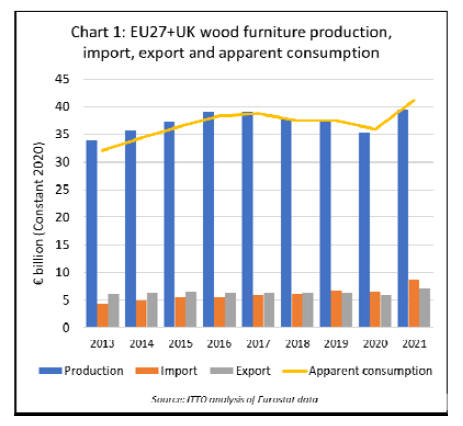
According to CSIL, the Milan based furniture research
organisation (www.worldfurnitureonline.com), the last
two years of the European furniture sector have been
marked by a significant mismatch between supply and
demand.
A sharp reduction in production of wood and other
essential material inputs, severe logistical problems in
international trade, rapidly rising freight rates, shortages of
key staff, social distancing measures at manufacturing
plants, and a big increase in energy prices all placed limits
on production and supply.
This meant that, while furniture production and imports
rebounded strongly in many European countries, they
failed to keep pace with an even sharper increase in
demand. The rise in demand was mainly due to a shift in
consumer spending away from travel and leisure towards
home-related product categories and to cater for new home
offices with the rise in remote working. There was also
resumption in export market growth in 2021.
The mismatch between demand and supply caused a
general increase in furniture prices, initially at the
manufacturing stage and partly absorbed by
manufacturers, and then progressively transferred to final
consumers.
Furniture sector performance varied widely between
European countries. Eurostat data shows that while overall
EU27 furniture production had rebounded to pre-pandemic
levels before the end of 2021, production was still below
these levels in many countries including Germany, France,
Sweden, and Romania. In contrast production in some
countries, notably Poland and Lithuania, remained strong
even during the first year of the pandemic in 2020, and
continued to rise in 2021 and the first half of 2022 (Chart
2).
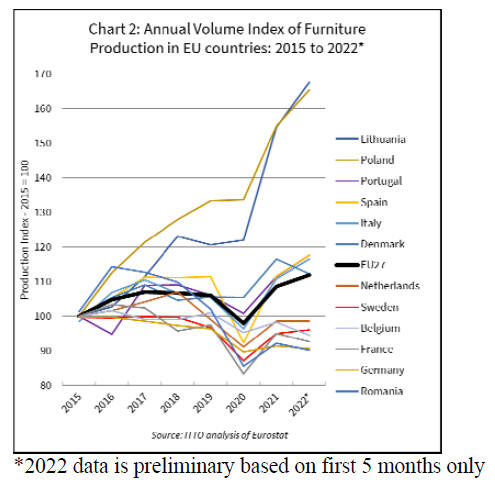
Looking forward, CSIL forecast that after the exceptional
rebound in European furniture production in 2021, 2022 is
expected to be another strong year on the demand side,
although the rebound effect will slow compared to last
year. This is partly due to reallocation of household
spending back towards travel and other leisure activities.
High inflation and soaring furniture prices are also
expected to have a dampening effect on down.
On the other hand purchasing in the commercial sector is
expected to remain robust.
Supply chain disruptions are expected to persist,
particularly due to rising energy prices, lack of qualified
workers, and the fallout from the Russia-Ukraine war. The
conflict is increasing material supply difficulties, notably
for timber products, and commodity prices are expected to
remain elevated at least for the remainder of this year. The
outlook for European inflation and wider economic growth
is heavily dependent on how the war in Ukraine will
unfold, the impact of sanctions and other measures, and
how these feed through into energy prices and consumer
confidence.
According to CSIL there are several positive factors
expected to maintain strong demand for furniture in
Europe in the coming months including the continuing
roll-out of the EU's Recovery and Resilience Facility
(RRF), some significant national level support measures,
such as a fiscal bonus in Italy which was extended into
2022, growth in residential construction in several
European countries, and improved export market prospects
for European manufacturers, driven both by increased
affluence of consumers in some emerging markets, and by
continuing efforts in the US to reduce dependence on
imports from China.
Recent trends in the quantity of European wood furniture
trade as revealed by Eurostat trade data are somewhat
surprising. The long-term rise in European trade which
began in 2013 as the European economy gradually
recovered from the 2008-09 global financial crises and
subsequent eurozone currency crisis, continued apparently
uninterrupted by the pandemic. The most notable recent
trend is the upturn in trade in 2021, apparent both in
EU27+UK external and internal trade (Chart 3).
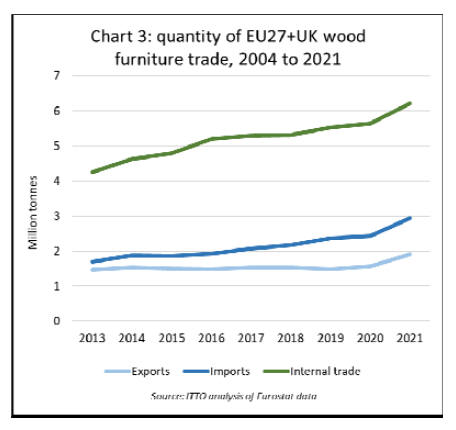
Overall, the signs are that EU wood furniture
manufacturers, while still dominant inside the EU single
market, accounting for around 80% of total consumption
value in the region, have been gradually losing
competitiveness in other global markets.
Exports by EU27+UK manufacturers to other regions of
the world were broadly flat in quantity terms and slightly
declining in value terms before 2021. Last year,
EU27+UK wood furniture exports to countries outside the
region increased sharply, rising 21% to both euro value
and quantity terms, but it remains to be seen whether this
growth can be sustained.
Meanwhile manufacturers outside the region, notably in
neighbouring non-EU countries and China, slowly
increased their share of the EU27+UK market in the years
before 2022. The share of non-EU suppliers in EU27+UK
wood furniture consumption increased to 21% in 2021, up
from 18% the previous year and 15% five years earlier.
Between 2015 and 2019, EU27+UK imports of wood
furniture from outside the region increased fairly
consistently at an average rate of 6% per year. In 2020, the
onset of the pandemic and related logistical problems led
to a slower rate of import growth of only around 3% to
2.44 million tonnes. Last year, import growth accelerated
sharply, rising over 20% to 2.93 million tonnes.
In recent years, by far the largest growth in EU27+UK
wood furniture imports in quantity terms was from China
(Chart 4). In terms of percentage growth rate, the largest
growth was from countries neighbouring the EU, notably
Turkey, Ukraine, Belarus, Serbia and Russia. EU27+UK
wood furniture imports from tropical countries averaged
no more than 2.4% per annum between 2015 and 2019,
and then fell 10% to 560,000 tonnes in 2020. Last year,
imports of tropical wood furniture rebounded 10% to
610,000 tonnes.
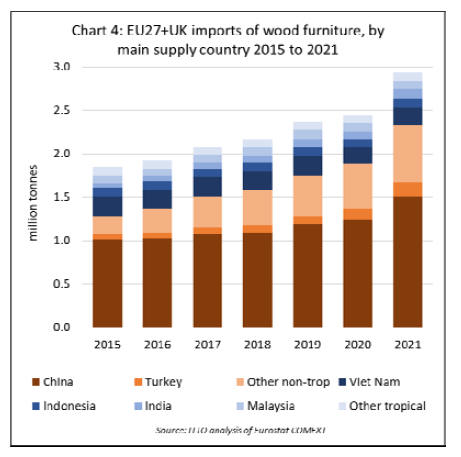
Notwithstanding CSIL¡¯s prediction of continuing good
demand for furniture in Europe in 2022, EU27+UK
imports of wood furniture were down 10% in quantity
terms, to 950,000 tonnes, in the first four months of this
year. Import tonnage decreased from all main supply
regions during the first four months of 2022; by 8% from
China to 460,000 tonnes, by 3% from the tropics to
230,000 tonnes; and by 17% from other countries to
260,000 tonnes (Chart 4).
The decline is indicative of severe supply problems caused
most notably by the renewed COVID lockdown in parts of
China, and the war in Ukraine and associated trade
sanctions against Russia and Belarus.
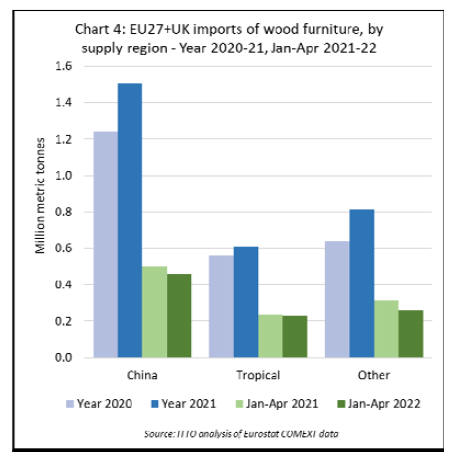
Of tropical countries supplying wood furniture to the
EU27+UK, Indonesia recorded the largest gain in this
market in the first four months of 2022, rising 18% to
42,000 tonnes. Imports also increased from Brazil, by 8%
to 22,000 tonnes.
Imports from Vietnam were stable at 82,000 tonnes.
Imports from all other leading tropical supply countries
declined, including India (-16% to 35,000 tonnes),
Malaysia (-15% to 37,000 tonnes), Thailand (-39% to
3,000 tonnes) and Singapore (-53% to 1,000 tonnes)
(Chart 5).
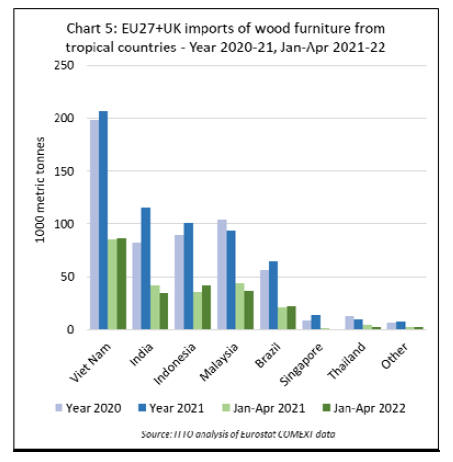
Tropical wood furniture import trends varied very widely
between EU27+UK countries in the opening months of
this year, with no clear pattern emerging (Chart 6).
In the first quarter of 2022, a rise in imports was recorded
in the UK (+8% to 57,500 tonnes), Germany (+6% to
23,800 tonnes), Belgium (+29% to 12,600 tonnes), Spain
(+7% to 7,000 tonnes), Italy (+9% to 4,300 tonnes) and
Ireland (+24% to 3,500 tonnes). However imports declined
into France (-8% to 25,900 tonnes), Netherlands (-16% to
16,900 tonnes), and Poland (-18% to 3,300 tonnes).
Imports into Denmark were stable at 4,400 tonnes during
the three month period.
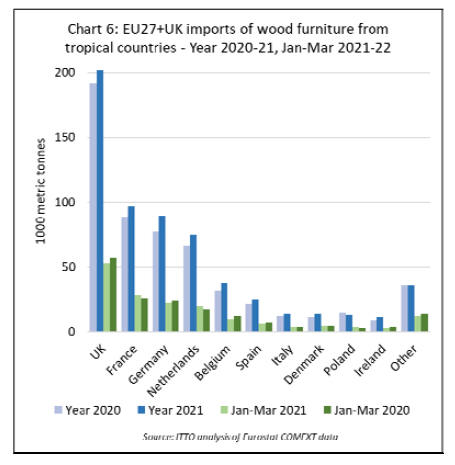
Major structural changes in European furniture
distribution
A new CSIL report highlights major structural changes in
Europe¡¯s furniture sector. Although some of the trends
have been underway now for at least a decade, recent
events have brought about accelerating change. According
to the report, major trends include:
An unprecedented increase in online sales that now
account for over 10% of the total European furniture
market. The pandemic outbreak accelerated a massive
change in consumer behaviour shifting from offline stores
to e-commerce. Moreover, the e-commerce channel has
bolstered international penetration enabling leading
furniture retailers to expand into new markets at lower
costs (including countries where they may have a limited
network of stores).
A slightly decreasing share of the overall market occupied
'specialist' retailers. This trend is mainly due to the
increasing role of the online channel that has eroded
market share of organized chains specialized in home
furniture and of independent stores. The latter particularly
suffered in 2020 during the months of lockdown.
Relative stability of market share of ¡®non-specialized¡¯
retailers. During and after the pandemic outbreak, home
improvement projects increased particularly benefitting
DIY chains. DIY chains were also able to remain open
during the months of the lockdowns while other
competitors were forced to close.
Changing behaviour of consumers impacting on
distribution of big supermarkets and hypermarkets.
Shopping districts in large towns and city centres have
become a far more attractive place to purchase. Leading
international furniture retail chains, such as IKEA and
Maisons du Monde are developing new store concepts.
For more than half a decade, IKEA has been a singleformat
retailer. However it is now investigating new ways
of meeting customer needs. For example by establishing
stores in inner-city locations and by balancing the big-box
superstore format with smaller format stores that use
digital technology to provide access to the full product
range.
More details are available the 2022 edition of CSIL report
¡°Furniture Retailing In Europe¡± which provides analysis
of home furniture distribution in 13 European countries
(Austria, Belgium, Denmark, Finland, France, Germany,
Italy, the Netherlands, Norway, Spain, Sweden,
Switzerland and the United Kingdom), including trends In
home furniture consumption, market forecasts, data by
country, analysis by distribution channel, retail formats
and sales performances of leading home furniture retailers.
See:
www.worldfurnitureonlIne.corn
Strong outdoor furniture market in Europe
The outdoor furniture market in Europe is one of the best
performers in the furniture sector, according to a new
report focused on this sector just published by CSIL. Total
annual sales of outdoor furniture in Europe are estimated
by CSIL to be around €3.3 billion. Following a slight
reduction in 2020 the sector recorded a double-digit
rebound in 2021, well above the sector average.
The largest outdoor furniture markets within Europe are
Germany, the United Kingdom, France, and Italy,
accounting for a combined market share of over 50%.
According to CSIL, consumption of outdoor furniture in
Europe is expected to continue to increase in 2022 and
2023.
During the first part of the pandemic (2020) the drop of
the outdoor furniture market was contained. Good retail
sales offset a sharp decline in contract sales. However,
starting from 2021 most manufacturers also experienced a
rebound of the contract sector as many activities put on
hold the previous year were restarted.
The hospitality industry is an component of outdoor
furniture demand in Europe. Official Eurostat statistics
released by Eurostat and reported by CSIL show a
significant fall in the number of hotels in Europe in 2020
as a main consequence of Covid-19.
However, with some of the world's most popular tourist
destinations, Europe has seen a revival in domestic and
inter-regional travel in the past year. International arrivals
to Europe increased nearly 75% in 2021.
There is now optimism that delayed projects in the hotel
and wider tourist sector will soon be completed.
According to data from Lodging Econometrics at the end
of 2021, Europe's hotel construction pipeline stood at
1,824 projects and nearly 300,000 rooms. A further 474
new hotels and 70,000 rooms are expected to open in 2022
and 504 new hotels with 75,015 rooms in 2023.
The outdoor sector is much more dependent on imports
than other furniture sectors in Europe. Slightly more than
half of all outdoor furniture imported by EU countries is
from countries outside the EU, with around 60% of non-
EU imports derived from China and 30% from tropical
countries in Southeast Asia.
There has been a long term rising trend in European
imports of outdoor furniture from outside the region,
although CSIL believes that recent factors, such as the raw
materials shortages and high freight rates may lead to a
partial reshoring of sourcing activities in the next few
years.
CSIL note that the outdoor furniture market is served via a
wide variety of channels, both specialist and non-specialist
distributors, from large scale retail chains to small
independent stores, and from 'pure' online players to brickand-
mortar operators.
Overall the role of non-specialist retailers is higher in this
sector than for most other furniture sectors such as
upholstery, kitchen furniture, and office furniture. DIY
chains and garden centres are still pivotal sales channels.
However, there has been some growth in sales via more
specialist retailers in recent years, first as the large-scale
furniture chains expanded outdoor collections and more
recently as more independent retailers are promoting
designer outdoor brands.
The e-commerce channel is also growing rapidly. Both
manufacturers and retailers are extending their web
marketing activity and upgrading their on-line presence.
No longer do they only display product pictures and
prices, but also seek to guide and inspire customers with
design suggestions and case studies.
On design and fashion trends, CSIL highlight the
increased focus on the interaction between indoor and
outdoor spaces within the home. Already a feature of the
market before the pandemic, it has become even more
significant during the lockdown period as consumers were
encouraged to enhance their home living experience.
More people have been turning outdoor areas into a 'green
living-rooms'. The borders between indoors and outdoors
are merging and there is more demand for dual purpose
furniture items that can be moved inside and out.
With high levels of urbanisation, there is particular
demand for furnishings for smaller gardens, roof terraces
and balconies.
Manufacturers are responding by producing narrow tables
and loungers and more multifunctional items, whose
backs, arms and sitting areas can be readily adjusted or
repositioned, to offer flexibility. Just as living rooms are
moving outdoors, so too are dining rooms. Manufacturers
are now developing flexible open-air dining room
furnishings such as extendable tables. Teak is still popular,
but more often than not it is combined with other materials
such as aluminium, ceramic, and waterproof outdoor
fabrics. And the strong focus on sustainability, low
environmental impact, and use of ¡°natural¡± and ¡°ecofriendly¡±
materials only grows stronger in Europe.
More details ¡®The European Market for outdoor furniture¡¯, CSIL,
May 2022,
www.worldfurnitureonline.com
Furniture sector needs new strategies in time of
uncertainty
An article by Mindaugas Morkunas, Head of Sales Eastern
Europe and CIS for Henkel, a German company supplying
chemicals to the worldwide furniture industry, highlights
key recent trends in the global furniture sector and
provides advice on strategic responses.
According to Morkanus, ¡°due to the global pandemic, the
international trade system experienced the biggest
disruption since the Second World War¡±. He notes the ongoing
¡°turmoil¡± in the furniture supply chain with
additional layers of uncertainty now appearing due to the
new COVID-19 outbreaks in China, Russia¡¯s war in
Ukraine, and other global challenges.
Morkanus suggests that the biggest risk for the furniture
industry in Europe is the possible recession. ¡°Some signs
are already there, as huge furniture players are decreasing
production since warehouses are already full. Buying
furniture while war is around the corner certainly isn¡¯t
among customers¡¯ top priorities¡±.
There are on-going significant changes in the way
furniture companies view supply chains and inventory,
says Morkanus. ¡°As it is getting difficult to predict
consumer demand, the furniture businesses are moving
from a Just-in-Time to a Just-in-Case approach.
The goal of this type of inventory management is to
minimize the probability that products will go out of stock.
Knowing all the challenges in the supply chain, producers
are trying their best to build stock with additional raw
materials. However, this can increase the backlog in
supply even more as demand is still growing¡±.He suggests
that now, more than ever, it is crucial for furniture
manufacturers to build a resilient supply chain.
He suggests three main ways to achieve this:
Moving closer to the market, or ¡°nearshoring¡±
which Morkanus notes from his own experience
is already happening. ¡°Geographically closer
countries can offer many benefits ¨C from
improving control of the supply market to quicker
transit for the end consumer¡±.
Moving to a lower price segment in production to
reach more customers. Morkanus suggests that
¡°as raw material, energy, and transport costs are
skyrocketing, furniture becomes more expensive.
The only way to still reach low-income customers
is to move towards the production of lower-cost
furniture using cheaper raw materials. The
drawback here is obvious ¨C the quality will
decrease. However, quality is not the main focus
for many customers nowadays ¨C affordability is
often more important¡±.
Securing alternative raw materials suppliers.
Morkanus observes that ¡°In most cases,
producers have one main supplier per raw
material. Now it seems like a good idea to move
towards having even 3-4 of them¡±.
See:
https://www.mdpi.com/2071-1050/12/11/4343
|